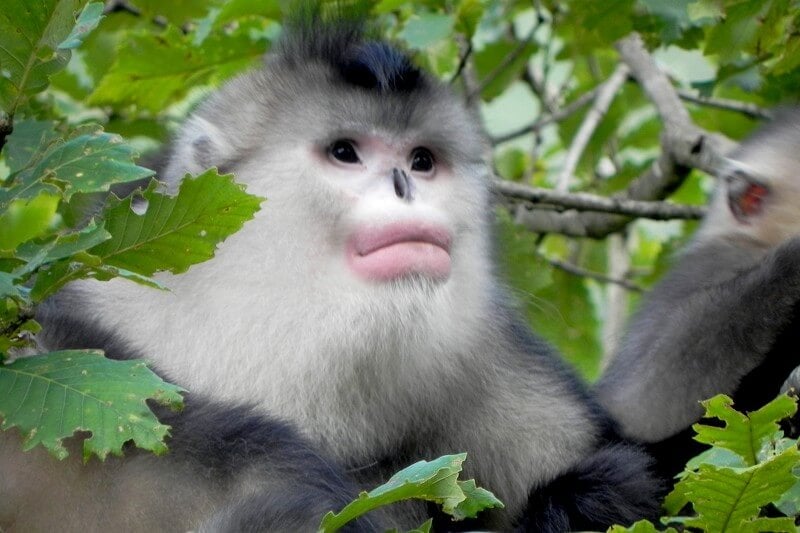Asian colobines, also known as leaf-eating monkeys, have been on the planet for about 10 million years. Their ancestors crossed land bridges, dispersed across continents, survived the expansion and contraction of ice sheets and learned to live in tropical, temperate and colder climes.
A new study reported in the journal Science finds parallels between Asian colobines’ social, environmental and genetic evolution, revealing for the first time that colobines living in colder regions experienced genetic changes and alterations to their ancient social structure that likely enhanced their ability to survive.
“Virtually all primates are social and live in social groups,” said study co-author Paul A. Garber, a professor emeritus of anthropology at the University of Illinois Urbana-Champaign and an expert on primate biology, evolution and conservation. “But the groups differ in size and cohesiveness. There are those that live in units of two or three individuals and others living in communities of up to 1,000 individuals.”
Asian colobines have evolved a variety of social structures. However, genomic studies suggest that the harem unit of organization, which consists of one male with two or more females and their offspring, was the ancestral norm for Asian colobines, Garber said. The males are intolerant of other males and will fight to protect their territories. In some species, females remain in their natal group. In others, both males and females leave to join or form a new harem.
Over time, more complex societies formed. Among a group of Asian colobines known as “odd-nosed monkeys,” for example, two genera “still form harems, but they’re not territorial,” Garber said. “This means their group territories can overlap and there are times they may come together to forage, rest and travel.” One branch of these odd-nosed monkeys, the “snub-nosed monkeys” form what is referred to as a multilevel or modular society in which several harems remain together year-round and form a large and cohesive breeding band.
The largest such society the team recorded included about 400 individuals. In the case of the golden snub-nosed monkeys, breeding between individuals belonging to different harems was common, occurring about 50% of the time.
The researchers wanted to examine how the interplay of environment, genes and behaviors like territoriality and cooperation allowed Asian colobines to survive in such varied habitats.
“The team used extremely diverse data sets, many of which we generated ourselves,” Garber said. “These include ecological and paleogeological data, the fossil record, and behavioral and genomic data.”
By overlaying social structure and habitat data, the team found that Asian colobine groups that inhabit colder areas – many of them at high elevations – also tend to form larger and more complex societies made up of harems that coordinate their daily activities and often cooperate with one another. The changes in social structure over time corresponded with genetic changes, the researchers found. The most socially complex multilevel societies also evolved changes in genes regulating cold-related energy metabolism and neurohormones that are known to play a critical role in social bonding.
Several factors contributed to the colobines’ social evolution into larger, more cooperative societies, Garber said.
“Because these primates are long-lived and individuals may remain in the same band for periods of years and even decades, you have the opportunity for high levels of reciprocal cooperation,” he said.
Habitat also played a role, he said. Smaller groups in tropical areas can afford to be territorial because food is more predictable, and they can sustain themselves in a fairly restricted area. However, life at higher altitudes is more challenging.
Black-and-white snub-nosed monkeys in some parts of China, for example, live at elevations up to about 13,500 feet.
“These are low-oxygen environments,” Garber said. “The coldest temperatures at night drop below zero. For a primate, that’s cold.”
Historically, predators of snub-nosed monkeys were large mammals like snow leopards, tigers and bears. Predation risk was likely lowered by the cooperative efforts of males from multiple harems, Garber said. In addition, plant resources consumed by snub-nosed monkeys are more spread out, making their extremely large territories – which can extend up to 6-8 square miles (15-20 square kilometers) – harder to defend by small groups.
In addition to changes in genes that code for lipid metabolism and adaptations associated with cold stress, colobines living at high elevations also saw genetic changes that bolstered hormones – such as oxytocin and dopamine – that are known to play a role in maternal behavior and social relationships.
“The snub-nosed monkeys seem to have a longer mother-infant bond, which probably increased infant survival in cold environments,” Garber said. “Oxytocin is an important neurohormone in all social bonding. We think it promoted social affiliation, cohesion and cooperation among adults as well.”
Each of these adaptive changes appears to have bolstered affiliation between harems, allowing Asian colobines to form larger multilevel societies when local conditions made it necessary for them to cooperate to survive, the researchers report.
The National Science Foundation of China, the Chinese Academy of Sciences and the Department of Science and Technology of Shaanxi Province supported this research.
Corresponding authors of the study are Xiao-Guang Qi, of Northwest University, Xi’an, China; Cyril C. Grueter, of the University of Western Australia, Perth; Dongdong Wu, of the Chinese Academy of Sciences, Kunming, China; and Baoguo Li, of Northwest University, China.
Garber also is affiliated with the Program in Ecology, Evolution and Conservation Biology, the Center for Global Studies and the Center for Latin American and Caribbean Studies at the U. of I.


